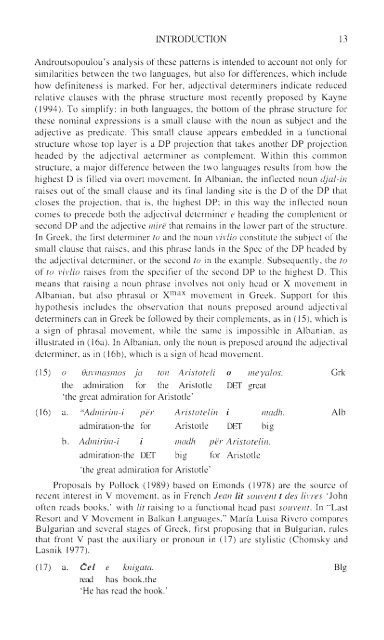Comparative Syntax of the Balkan Languages (Oxford ... - Cryptm.org
Comparative Syntax of the Balkan Languages (Oxford ... - Cryptm.org
Comparative Syntax of the Balkan Languages (Oxford ... - Cryptm.org
- No tags were found...
You also want an ePaper? Increase the reach of your titles
YUMPU automatically turns print PDFs into web optimized ePapers that Google loves.
INTRODUCTION 13Androutsopoulou's analysis <strong>of</strong> <strong>the</strong>se patterns is intended to account not only forsimilarities between <strong>the</strong> two languages, hut also for differences, which includehow definiteness is marked. For her, adjectival determiners indicate reducedrelative clauses with <strong>the</strong> phrase structure most recently proposed by Kayne(1994). To simplify: in both languages, <strong>the</strong> bottom <strong>of</strong> <strong>the</strong> phrase structure for<strong>the</strong>se nominal expressions is a small clause with <strong>the</strong> noun as subject and <strong>the</strong>adjective as predicate. This small clause appears embedded in a functionalstructure whose top layer is a DP projection that takes ano<strong>the</strong>r DP projectionheaded by <strong>the</strong> adjectival aeterminer as complement. Within this commonstructure, a major difference between <strong>the</strong> two languages results from how <strong>the</strong>highest D is filled via overt movement. In Albanian, <strong>the</strong> inflected noun djal-inraises out <strong>of</strong> <strong>the</strong> small clause and its final landing site is <strong>the</strong> D <strong>of</strong> <strong>the</strong> DP thatcloses <strong>the</strong> projection, that is, <strong>the</strong> highest DP; in this way <strong>the</strong> inflected nouncomes to precede both <strong>the</strong> adjectival determiner e heading <strong>the</strong> complement orsecond DP and <strong>the</strong> adjective mire that remains in <strong>the</strong> lower part <strong>of</strong> <strong>the</strong> structure.In Greek, <strong>the</strong> first determiner to and <strong>the</strong> noun vivlio constitute <strong>the</strong> subject <strong>of</strong> <strong>the</strong>small clause that raises, and this phrase lands in <strong>the</strong> Spec <strong>of</strong> <strong>the</strong> DP headed by<strong>the</strong> adjectival determiner, or <strong>the</strong> second to in <strong>the</strong> example. Subsequently, <strong>the</strong> to<strong>of</strong> to vivlio raises from <strong>the</strong> specifier <strong>of</strong> <strong>the</strong> second DP to <strong>the</strong> highest D. Thismeans that raising a noun phrase involves not only head or X movement inAlbanian, but also phrasal or X max movement in Greek. Support for thishypo<strong>the</strong>sis includes <strong>the</strong> observation that nouns preposed around adjectivaldeterminers can in Greek be followed by <strong>the</strong>ir complements, as in (15), which isa sign <strong>of</strong> phrasal movement, while <strong>the</strong> same is impossible in Albanian, asillustrated in (16a). In Albanian, only <strong>the</strong> noun is preposed around <strong>the</strong> adjectivaldeterminer, as in (I6b), which is a sign <strong>of</strong> head movement.(15) o davmasmos ja ton Aristoteli o me meyalos. Grk<strong>the</strong> admiration for <strong>the</strong> Aristotle DET great'<strong>the</strong> great admiration for Aristotle'(16) a. *Admirim-i per Aristotelin i mmadh. Albadmiration-<strong>the</strong> for Aristotle DET bigb. Admirim-i i i madh dh per Aristotelin.admiration-<strong>the</strong> DET big for Aristotle'<strong>the</strong> great admiration for Aristotle'Proposals by Pollock (1989) based on Emonds (1978) are <strong>the</strong> source <strong>of</strong>recent interest in V movement, as in French Jean lit souvent t des lirres 'John<strong>of</strong>ten reads books,' with lit raising to a functional head past soitvent. In "LastResort and V Movement in <strong>Balkan</strong> <strong>Languages</strong>." Maria Luisa Rivero comparesBulgarian and several stages <strong>of</strong> Greek, first proposing that in Bulgarian, rulesthat front V past <strong>the</strong> auxiliary or pronoun in (17) are stylistic (Chomsky andLasnik 1977).(17) a. Cel e knigata. Blgread has book.<strong>the</strong>'He has read <strong>the</strong> book.'
















